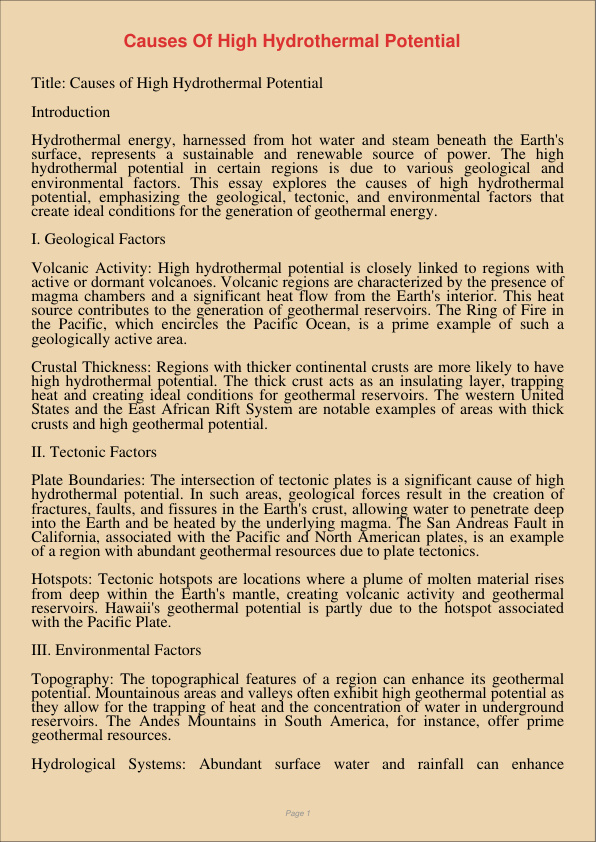
Title: Causes of High Hydrothermal Potential
Introduction
Hydrothermal energy, harnessed from hot water and steam beneath the Earth’s surface, represents a sustainable and renewable source of power. The high hydrothermal potential in certain regions is due to various geological and environmental factors. This essay explores the causes of high hydrothermal potential, emphasizing the geological, tectonic, and environmental factors that create ideal conditions for the generation of geothermal energy.
I. Geological Factors
Volcanic Activity: High hydrothermal potential is closely linked to regions with active or dormant volcanoes. Volcanic regions are characterized by the presence of magma chambers and a significant heat flow from the Earth’s interior. This heat source contributes to the generation of geothermal reservoirs. The Ring of Fire in the Pacific, which encircles the Pacific Ocean, is a prime example of such a geologically active area.
Crustal Thickness: Regions with thicker continental crusts are more likely to have high hydrothermal potential. The thick crust acts as an insulating layer, trapping heat and creating ideal conditions for geothermal reservoirs. The western United States and the East African Rift System are notable examples of areas with thick crusts and high geothermal potential.
II. Tectonic Factors
Plate Boundaries: The intersection of tectonic plates is a significant cause of high hydrothermal potential. In such areas, geological forces result in the creation of fractures, faults, and fissures in the Earth’s crust, allowing water to penetrate deep into the Earth and be heated by the underlying magma. The San Andreas Fault in California, associated with the Pacific and North American plates, is an example of a region with abundant geothermal resources due to plate tectonics.
Hotspots: Tectonic hotspots are locations where a plume of molten material rises from deep within the Earth’s mantle, creating volcanic activity and geothermal reservoirs. Hawaii’s geothermal potential is partly due to the hotspot associated with the Pacific Plate.
III. Environmental Factors
Topography: The topographical features of a region can enhance its geothermal potential. Mountainous areas and valleys often exhibit high geothermal potential as they allow for the trapping of heat and the concentration of water in underground reservoirs. The Andes Mountains in South America, for instance, offer prime geothermal resources.
Hydrological Systems: Abundant surface water and rainfall can enhance geothermal potential by providing a water source for injection into the Earth to create steam for energy generation. Iceland, with its numerous rivers and high precipitation rates, is a prime example.
Conclusion
High hydrothermal potential is a result of the complex interplay of geological, tectonic, and environmental factors. Regions with active or dormant volcanoes, plate boundaries, thick continental crusts, and topographical features conducive to heat trapping are more likely to have an abundant supply of geothermal energy. Harnessing this potential offers an environmentally friendly and sustainable source of power, reducing reliance on fossil fuels and contributing to a greener energy future. Understanding the causes of high hydrothermal potential is crucial for the responsible development and utilization of geothermal resources worldwide.
「真诚赞赏,手留余香」
真诚赞赏,手留余香
使用微信扫描二维码完成支付
